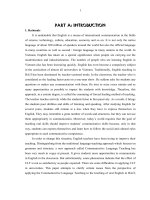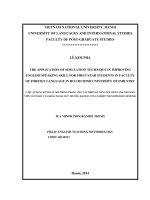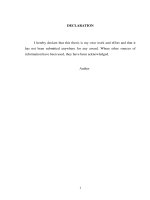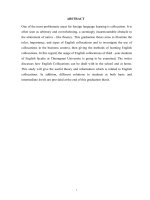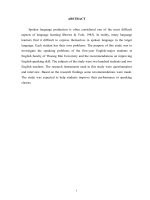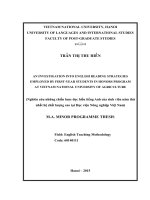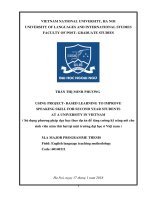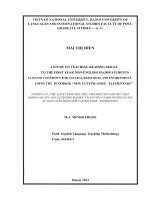A study on improving english speaking skill for first year students in english faculty at thuong mai university
Bạn đang xem bản rút gọn của tài liệu. Xem và tải ngay bản đầy đủ của tài liệu tại đây (266.77 KB, 43 trang )
ABSTRACT
Spoken language production is often considered one of the most difficult
aspects of language learning (Brown & Yule, 1983). In reality, many language
learners find it difficult to express themselves in spoken language in the target
language. Each student has their own problems. The purpose of this study was to
investigate the speaking problems of the first-year English-major students at
English faculty of Thuong Mai University and the recommendations on improving
English speaking skill. The subjects of the study were two hundred students and two
English teachers. The research instruments used in this study were questionnaires
and interview. Based on the research findings some recommendations were made.
The study was expected to help students improve their performance in speaking
classes.
11
1
1
ACKNOWLEDGEMENTS
First and foremost, I would like to send my deepest gratitude to Mrs. Luong
Thi Minh Phuong, the supervisor of this graduation paper. Her detailed comments
and useful advices helped me to shape my ideas and to finish the graduation paper
as expected. She also created favorable condition and provided many materials as
well as encouragements for me to fulfill this study. Therefore, it is an undeniable
fact that this study would not have been finished without her invaluable support.
Secondly, I would like to express my particular appreciation to all the lecturers
of the English Faculty whose lectures have enriched my English knowledge during
the past 4 years.
Student
Nguyen Phuong Anh
12
2
2
TABLE OF CONTENTS
13
3
3
LIST OF TABLES, DIAGRAMS AND FIGURES
No.
Name
Content
Page
1
Table 1
Students difficulties while speaking English
23
2
Table 2
Students’ opinions on TMU English courses
25
3
Chart 1
Students’ opinion on learning English speaking
21
4
Chart 2
Students’ frequency in practicing English speaking
22
5
Chart 3
Students self-assessing their speaking skill
22
6
Chart 4
Students’ ability to keep up with English classe;s of
students
23
7
Chart 5
Methods and techniques students have used to promote
speaking skill
24
14
4
4
LIST OF ABREVIATIONS
No.
1
2
5
6
15
Words
Abreviation
Thuong Mai University
Hai Phong University
English faculty
Effortless Commerce Speaking
TMU
HPU
EF
ECS
5
5
CHAPTER 1: OVERVIEW OF THE STUDY
1.1 Rationale of the study
In Vietnam, the education system is still leaning towards to theoretics more
than practice. Students from public primary schools to high schools are spending
more time reading how to make things instead of actually putting it into action. In
other words, a large number of students do not get to apply what they have learned
into real life. For example in chemistry classes, students usually can only watch
their teachers doing some simple experiments due to the shortage of equipment.
This will led to the lack of practical knowledge and eventually limit students’
abilities. Among the subjects that require a lot of practicing, there is English. For
years English has been considered one of the most used languages in the world and
has become a common tool to communicate between countries. Realizing the
importance of English, Vietnam has been strongly investing in English teaching in
the education system but according to a recent research, 80% of Vietnamese
students spend 7-10 years studying English and only 20% of which can speak
English fluently. This fact showed that the system should be focusing more on
English speaking skill in order to develop all skills equally.
As a senior student in English faculty at Thuong Mai University who also had
been a freshman, the researcher has noticed that most first-year students have hard
time catching up with English courses due to their poor performance, especially in
speaking skill. Poor performance happens due to the change of teaching methods,
learning environment, etc, which leads to failing courses or dropping scores. In high
school, English classes mainly focus on grammar and vocabulary while in college,
speaking skill has a more important role. Students have to use English to
communicate while in English classes, to make speech and presentations using
English, something they are not familiarized within lower education. These changes
have made first-year students struggle to cope with and usually took them months
or even years to figure out techniques to improve their speaking skill.
After ackowledging the problem, in this study, the researcher will explore the
factors which affect English speaking skill and the actual situation of the teaching
6
and learning condition at TMU as well as give some recommendations on
improving speaking skill effectively.
The study is carried out in order to help improving English speaking skill for
first-year English majored students. The official title of the study is: “A study on
improving English speaking skill for first-year students in English faculty at
Thuong Mai University”. Through this study, the researcher hopes it can provide
the information of ways to overcome the weaknesses while speaking English and
furthermore to help students become fluent English speakers.
1.2 Aims of the study
The first objective of this study is to identify the obstacles that students
usually face while speaking English. The second objective is to suggest realistic and
effective ways to improve English speaking skill for first-year English-major
students based on the obstacles. The study focuses on resolving these two main
questions:
-
What are the difficulties that first-year English-major students face while
-
speaking English?
What are the effective ways to help improve English speaking skill for first-year
English-major students?
1.3 Scope of the study
The study focuses on first-year English-major students at TMU in the last half
of the 2017-2018 second semester due to the limitation of time and is conducted on
200 students in one month time. This study also emphasizes on the speaking skill of
these students. Base on that, the recommended techniques and methods on
improving English speaking skill are specifically created for English-major students
in general and first-year English-major students in particular.
1.4 Research subject
At English faculty, the students come from provinces across the country with
different backgrounds. Despite the differences, their English level is quite
comparable. However, after observing, the researcher discovers that a specific
amount of students have problems with their speaking skill, especially first-year
students of EF. The change of teaching methods and way of studying in college
7
confuses them. They admitted that English speaking is not their strength and most
of them did not spend much time improving the skill while in secondary school and
high school as a result of speaking was not important in the learning process. Still,
they understand the importance of English speaking skill and are looking for a
resolution for this problem.
1.5 Previous studies
Up to this point, there has been a significant of studies on improving English
oral communication skill. While some of them suggested different techniques,
methods and activities on English teaching or English learning, the others point out
elements which affect speaking ability.
Prieto (2007) performed a study about the cooperative learning tasks. The
findings of her study showed that one way to improve speaking skill is to interact
with others, learn from others, and the choice of the topics based on the learners’
interests in order to encourage them. In other words, the study emphasizes on
promoting the learning method for English learners, practicing English with
partners in particular. There was no given information on suggestions on English
teaching.
Le Thi Thu Hang (2010) carried out a study on improving speaking skill for
7th grade students for which mainly
focuses on the importance of
teaching methods and how the methods will help young students with their speaking
skill as well as suggestions on several techniques for implication in classes. The
main participants of this study are the 7th grade students, in other words, they are
young teenagers so the methods suggested are related to fun activities and games in
order to make English classes more interesting for these students. Nevertheless, this
study alone does not provide any studying methods for the students but only give
recommendations for the teachers.
Bozorgian (2012) investigated the relationship between listening skill and the
other language skills. The results revealed that there is a close relation between
listening comprehension and language proficiency. That is, the higher the listening
skill, the better the speaking skill. The author also stated in the study that to enhance
verbal communication skill, learners should be enhancing their listening skill as
8
well. Despite this statement, the author did not mention any approach to improve
listening skill.
In another study, Phung Thi Son (2013) examined the factors which have
negative impact on HPU first-year English-major students’ speaking skill and
moreover, give recommendations on the teaching techniques. The researcher shows
that a majority of first-year students at HPU have poor English speaking skill and
suggests helpful techniques with the hope to solve the problem. However, the study
stops at suggestions for teachers and a few simple methods for the students.
In conclusion, all the studies mentioned above are related to speaking skill, the
importance of speaking skill as well as ways to improve this significant skill but
none of which seems to have enough options for English learners, especially
students. With the attempt to help students improve their English speaking skill, this
study is carried out to provide suggestions which are believed to be most suitable
for them.
1.6 Methodology
The main method uses to conduct this study is qualitative method. A survey
questionnaires and an interview is also carried out to collect data in order to
understand first-year English-major students attitudes towards learning English
speaking and discover the difficulties while speaking English to find out most
suitable methods and techniques to improve their speaking skill.
1.6.1 Data collection
First data collection method is the survey questionnaires. For this survey, a
total of 200 first-year English-major students in random classes of TMU are
selected to answer 7 questions for this study to collect data. Due to the limitation of
time, the researcher only focuses on the last half of the 2017-2018 second semester.
As having studied the English 1, these students have experienced the teaching
methods as well as how the course is organized. The main objective of this survey
to explore the cause of first-year English majored students difficulties with speaking
skill by analyzing students’ attitudes towards English and how they spend time to
practice speaking as well as main obstacles while communicating using English.
9
The second data collection method uses is interview. Two English teachers are
interviewed with two questions on their perspective of TMU English teaching
system and their ideas on how to develop students’ English speaking ability through
their teaching methods.
1.6.2 Data analysis
After having been collected through the data collection process, the gathered
information is put into investigation and analysis. Data analysis would be carried
out following the data collection procedure.
1.7 Structure of the study
The study consists of 4 main chapters and the conclusion
-
Chapter 1 is the Overview of the study. In this very first part, the researcher will
explain the reason of choosing this topic as well as the aims of the study, scope, the
research subject, summary of the previous studies, the methodology and the
-
structure of the study.
Chapter 2: Literature review aims to answer questions related to definition and the
importance of speaking skill as well as speaking skill teaching and learning
-
methods.
Chapter 3: Research findings resolves the first research question by analyzing the
-
data collected from the survey questionnaires and interview.
Chapter 4: Recommendations and suggestions resolves the second research
questions by recommends adequate methods and techniques on improving students’
-
speaking skill and teachers’ teaching methods
The Conclusion which summarizes all the presented information as well as the
limitations of the study and suggestions for further studies.
CHAPTER 2: LITERATURE REVIEW
10
For this chapter, first, the author presents briefly the history of English, its
influence on the nowadays society as well as the general situation of practical
English using in Vietnam. The second and third part explains the definition of
English verbal skill and the importance of this significant skill. The last part focuses
on the importance of teaching and learning methods and also its impact on the
learning process.
2.1 Definition of speaking and speaking skill
Over the years, there are a lot of definitions of speaking. As someone have
said speaking is an act of making vocal sounds based on the needs of expressing
feelings, thoughts, sharing ideas or knowledge in spoken language. According to
Chaney (1998), speaking is the process of making and sharing meaning by using
verbal and non-verbal indications in different context. As stated by Webster New
World Dictionary, speaking is to say words orally, to communicate by talking, to
make a speech (Nunan, 1995).
Speaking is also considered an interactive process of making meaning that
includes producing, receiving and processing information (Brown, 1994 Burns and
Joyce, 1997). Another definition of speaking from Eckard and Kearny (1981),
Howarth (2001) and Abd El Fattah Torky (2006) stated that speaking is a two-way
process including a true communication of opinions, information or emotions.
Speaking skill is the ability to communicate at some level which helps human
communicate effectively. Speaking is the most important language skills among
reading skill, listening skill and writing skill.
In short, the researcher consider speaking is a complex process which takes
place in real life and requires the collaboration of different types of knowledge
regarding with good using of certain skills, involved with multiple factors and the
efficiency of speaking depends on the speakers’ previous experiences, physical
setting and the purpose of speech (Bygate, 1987 Brown,1994).
11
2.2 The significance of English speaking skill
In terms of speaking, when talk about speaking, it does not mean just saying
the words through mouth but also delivering the message through the words of
mouth. In addition, speaking is the most used skill among the four main language
skills. Rivers (1981) studied the use of language outside the classroom situation and
discovered that speaking is used twice as much as reading and writing combined.
Nunan (1999) and Burkart & Sheppard (2004) argue the success in learning a
language is measured in terms of the ability to carry out a conversation in the target
language. According to Brown (1994), listening and speaking are learners’ language
tools. Therefore, speaking is presumably a priority for most English learners
(Florez, 1999). In addition, speaking can support other language skills. Recent
research has considered oral interaction as an important factor in the shaping of the
learner's developing language (Gass & Varionis, 1994). Correspondingly, it was
proved that learning speaking can help the development of reading capability
(Hilferty, 2005), the development of writing (Trachsel & Severino, 2004) as well as
the development of listening skills (Regina, 1997). Of the most difficult skills
language learners face in language learning is speaking skill. It is believed that
speaking is the most important of the four language skills. Many learners state that
they have spent so many years studying English language but cannot speak it
appropriately and understandably (Bueno, Madrid, & Mclaren, 2006).
Speaking is one of the most important skills of all the four language skills
because individuals who learn a language are referred to as the speakers of that
language (Ur, 1996). The main aim of English language teaching is to give learners
the ability to use English language effectively and correctly in communication
(Davies & Pearse, 2000). However, it seems that language learners are not able to
communicate fluently and accurately because they do not have enough knowledge
in this field.
According to Harmer (2007) and PourhoseinGilakjani (2016), human
communication is a complex process. Persons need communication when they want
to say something and transmit information. Speakers use communication when they
are going to inform someone about something. Speakers apply language according
12
to their own goals. So speakers should be both listeners and speakers at the same
time for the effective communication.
Efrizal (2012) PourhoseinGilakjani (2016) expressed that speaking is of great
significance for the people interaction where they speak everywhere and every day.
Speaking is the way of communicating ideas and messages orally. If we want to
encourage students to communicate in English, we should use the language in real
communication and ask them to do the same process.
Richards and Rodgers (2001) stated that in the traditional methods, the
speaking skill was ignored in the classrooms where the emphasis was on reading
and writing skills. For example, in The Grammar-Translation method, reading and
writing were the important skills and speaking and listening skills were not of great
significance. According to Ur (2000), of all the four language skills called listening,
speaking, reading, and writing, speaking is the most important one that is very
necessary for the effective communication. Baker and Westrup (2003) who said that
learners who speak English very well can have greater chance for better education,
finding good jobs, and getting promotion.
2.3 Teaching English speaking
2.3.1 The role of the teacher
Harmer (2007) states that except a prompter and a feedback provider, a
teacher's role is also a participant, whose aim should be to comment, keep an eye
contact and show facial expressions, which should impress and encourage learners.
Ur (1996) and Brown (1983) call such assessment formative evaluation, whose
purpose is forming and enhancing in contrast to summative evaluation, which is a
result of a long process and takes place at the end of a term.
The atmosphere for the speaking fluency development in a class is highly
influenced by teachers' reactions, which are besides formal assessment an important
part of teacher's feedback. Klippel (1984, p.6) makes quite a critical remark when
he claims that a lot of teaching situations never get beyond a rational plus fact
oriented stage. Considering feedback at least some informal sharing of feelings and
ideas in a form of oral praise or warning between a teacher and the pupils should
take place during the lessons.
13
Although drilling may not sound suitable for teaching speaking fluency,
Thornbury (2007, p. 64) lifts up the importance of repetitive practice, which can
follow after pointing out some particular mistakes, as a tool that moves the items
into long-term memory. They can later function as a store of memorized phrases or
chunks on which a learner can depend. The long-term aim must always be to ask
students to demonstrate that they learn to use, not to repeat, what they have been
taught (Brown, 1983).
To sum up, teacher's feedback plays a significant role in learner's fluency
speaking development. All the teacher's positive reactions and encouragement
contribute to the efficient learning process of speaking and on the other hand
teacher's impatience or even emphasizing learners' inability can greatly discourage
learners from their efforts.
2.3.2 Activities for teaching English speaking
a. Role plays, simulations and discussions
A division of communicative tasks, which is used by many authors, is roleplay, simulation and discussion. In a role-play learners pretend to be someone else
and do what is set for them to do, e. g. an unwilling shop assistant. A teacher can
hand out the roles in a form of role-cards where each learner reads the role which he
will play.
On the other hand, in a simulation learners play themselves in a simulated
situation and do what has been set for them to do. They might be e. g. phoning to
arrange a meeting. In discussion each one is himself or herself and does not have a
set task what to say, e.g. Balloon debate – a popular discussion game where learners
are pretending being balloon passengers which is overloaded and must persuade the
others why they should be saved and not sacrificed (Thornbury 2007, p. 98).
Wingate (1993, p. 43) recommends all of these three kinds of tasks because
they protect your students inner selves from suffering any blows to their confidence
and morale while getting to use the new items of language. Bygate (1987, p. 59)
stresses the importance of using such activities because they are opportunities for
learners to use English for various purposes of language, for the situation outside
the class.
14
All the activities, mentioned in this chapter, serve as examples of the activities
whose application in English lessons greatly contributes to learners' fluency
speaking development, however, an overall teacher's support within the lessons,
aiming at the usage of all the opportunities to activate learners' speaking as much as
possible, is also undoubtedly an inseparable component of learners' fluency
speaking development. Using classroom English, warm up and follow up speaking
activities as well as informal chat in a form of teachers' comments on what is going
on during lessons highly contribute to the whole process just as teacher's feedback
which is discussed in the final chapter of the theoretical part of the thesis.
b. Using pictures
Different possibilities how to use pictures for developing speaking fluency are
described by Bygate (1987, p. 71). A similar game as Picture differences is a game
Finding similarities. Two different pictures are handed out per pair and the aim is, not
looking at each other picture, to find as many similarities as possible. An activity
Describe and arrange uses a picture story, consisting from four pictures, where one
learner has the pictures in the right order and the other must listen to the story to
arrange his pictures in the same way. In a Story construction activity four members
of a group are given a different picture and are to compile a story together.
Identifying a picture from a set is an activity where one learner from a pair has
a set of pictures and has to identify just one of them which the other one is holding
(Littlewood, in Bygate, 1987, p. 67).
c. Feedback and oral testing
-
Feedback variety:
Harmer (2007) sees a clear difference between feedback during 'noncommunicative' activities, which intends to measure correctness (e.g. grammar,
vocabulary), and 'communicative activities', whose aim is to improve fluency. A
clear difference is understood also by Brown (1983, p.53), who claims 'when a
student is trying to formulate and structure a long turn in a foreign language, the last
thing a teacher should be thinking of is correcting that student's pronunciation'.
15
-
Mistakes correction:
There are many ways how mistakes can be pointed out and corrected.
Thornbury (2007, p.60) claims that learners are able to identify many of their own
mistakes themselves. One way, how it could be done, is to record their performance
and when playing back, they have a chance to evaluate it. Another way of correcting
learners' mistakes is noting them down by a teacher during fluency speaking
activities and subsequent analysis either with a whole class or an individual. Correct
forms can be elicited from the students, or be written on the board or a teacher can
prepare some kind of extra practice, which help learners with their difficulties. Any
kind of correcting is chosen, teachers should always regard as very important not to
let awareness of errors outweigh the importance of the whole speaking activity
(Ladousse,1987, p.15).
-
Feedback timing:
Some authors (Ur, 1996, Harmer, 2007) warn teachers not to disturb pupils'
oral production in the middle of their speech and not to concentrate on trivial
mistakes but recommend to interfere only if learners flounder about or
misunderstand each other. Making mistakes is an unavoidable part of any learning
process and there is always time after the activity when mistakes should be assessed
and corrected. Some teachers claim that they cannot let errors go even in fluent
activities, but it is important if the interventions are economical and effective and
the stream of words and thoughts is not threatened. This is probably possible only
when dealing with mistakes, which represent momentary failure, not errors, which
mean a weak point in a learner's knowledge (Thornbury 2007, p.92). From my point
of view it is just errors, which should not remain uncorrected as they could ruin the
meaning of the whole activity.
-
Oral testing:
When dealing with oral testing, Ur (1996) mentions some advantages and
disadvantages as well. She is persuaded that testing language knowledge should
include all the language skills, including speaking, because besides the fact, that
some students can speak well but write badly, if there is an oral test ahead, more
attention is paid to its practice. On the other hand, she admits it is a great investment
16
of time and speaking is also very difficult to judge quickly and objectively. To
prevent pupils' and parents' feeling that oral testing can be biased, Anderson (1984,
p.76) suggests an assessment procedure which, used by different teachers, leads to
agreed scoring. He believes, if concentrating at teaching speaking fluency, teachers'
judgement should not be aimed at faultless precision but at transferring all the
necessary information slots, such as e. g. colour, size, direction and so on, which
would be allocated one point each. Other language aspects, such as pronunciation,
choice of vocabulary or rhetorical style are recommended not be assessed
(Anderson 1984, p.76).
In contrast to Anderson's (1984) suggestion, Brown (1983) describes assessing
spoken English production as a whole. In order to maintain such assessment which
would contain different aspects of the learner's speech, he suggests to use an
informal chart:
Type of
Date
speech
required
Grammatical Appropriate
correctness vocabulary
Fluency / Information
pronunciat
transfer
ion
score
Others
(Brown, 1984, p.104)
As some of the categories in the above table, including fluency, are assessed
subjectively, the other possibility, how to support the teacher's objective judgments,
is to tape-record students' speech. Moreover, the same principle, of encouraging
learners to pay more attention to their performance, which is used in teaching
writing, would be implemented for speaking production.
In the researcher‘s opinion, some kind of oral testing should have its place in
English lessons, especially in basic schools where children are considered as
beginners. Emphasis on oral production at the beginning of a learning process of a
foreign language, as it has already been mentioned in this work, should be a natural
part of learning, similarly to the learning process of mother tongue. Although oral
17
testing may seem not so objective as testing written production, it gives learners an
opportunity to have all the language skills tested and can serve as a tool which leads
to paying more attention to its practice.
2.4 Learning English speaking
2.4.1 Vocabulary
a. Defining Word and Vocabulary
“1” (Foley and Thompson 2003, p. 10). However, before discussing the
importance of vocabulary and other issues concerning vocabulary learning, a clear
distinction between the terms word and vocabulary should be made. Some scholars
(e.g. Bowen et al., 1985; Jackson and Amvela, 2000; Read, 2000; Trask, 1995)
indicate that ‘word’ may be easy to perceive, but is hard to define. Trask (1995, pp.
46-51) points out that “there are the difficulties in the definition of the word because
words do not have meanings in isolation, but they are related to the meanings of
other words in ways that may be simple or complex”. Moreover, “a word, at least,
relates to the fields of morphology, semantics, etymology or lexicology” (Jackson
and Amvela 2000, p. 48).
Since the term ‘word’ is difficult to define, and the main purposes of the
present investigation emphasise vocabulary learning strategies used by language
learners to learn or acquire vocabulary items; therefore, the researcher does not look
into the history of words or any aspects related to a word except defining the terms
‘word’ and ‘vocabulary’ in this section. Instead, the researcher attempts to
distinguish particularly the term word and vocabulary that best suit the context of
the present investigation with the hope that it may result in a better understanding of
the term ‘vocabulary learning’.
A few researchers, such as Jackson and Amvela (2000); Richards et al. (1992);
and Hornby et al. (1984), have viewed word and vocabulary in a comparative way.
Word is “an uninterruptible unit of structure consisting of one or more morphemes
and which typically occurs in the structure of phrases. The morphemes are the
ultimate grammatical constituents, the minimal meaningful units of language”,
while vocabulary (which is synonymous with ‘lexis’, or ‘lexicon’) is viewed as “a
collection of words” or “a package of sub-sets of words that are used in particular
18
contexts”. Richards et al. (1992) define the term word as “the smallest of the
linguistic units which can occur on its own in speech or writing” (p. 406), but
vocabulary, as “a set of lexemes which includes single words, compound words and
idioms” (p. 400). Besides, word is defined as “sound or combination of sounds
forming a unit of the grammar or vocabulary of a language”, whereas vocabulary
as “the total number of words which make up a language; and a range of words
known to, or used by a person” (Hornby et al., 1984). In addition, regarding the
definition of word and vocabulary, a word is “a unit formed of sounds or letters that
have a meaning” (Sheeler and Markley 2000, p. 2), while vocabulary is defined as
“total number of words we know and are able to use” (Nandy 1994, p. 1; Sesnan
2001, p. 123).
We can see, based on some scholars’ view points of word and vocabulary, that
word is the smallest meaningful unit of language used for making phrases and
sentences that usually represents an object, idea, action, etc. Vocabulary is seen as
“a set of lexemes - the study of vocabulary items – which includes single words,
compound words and idioms”. In other words, a word is a form which can occur in
isolation and have meaning, or a sound or combination of sounds forming a unit of
the grammar or vocabulary of a language, and so act as ‘a part of vocabulary’ in a
language. Therefore, vocabulary consists of more than just single words (Read
2000, p. 20; Richards 2000, p. xi), and more than this, vocabulary concerns not only
simple words in all their aspects, but also complex and compound words, as well as
the meaningful units of language (Jackson and Amvela 2000, pp. 1-2). Regarding
vocabulary learning, there is no question that vocabulary learning is referred to as
learning “A collection or the total stock of words in a language that are used in
particular contexts”. To be precise, vocabulary learning means learning a package of
sub-sets of words as well as learning how to use strategies to cope with unknown or
unfamiliar words.
b. The importance of vocabulary
Of all the language skills, it is widely acknowledged that vocabulary is a very
important part in English language learning and that no one can communicate in
any meaningful way without vocabulary. Bowen et al. (1985, p.322) and McCarthy
19
(1990, p. iix) indicate that the single, biggest component of any language course is
vocabulary. This is consistent with Nation (1990, p.2) who affirms that learners also
see vocabulary as being a very, if not the most, important element in language
learning. Learners feel that many of their difficulties, in both receptive and
productive language use, result from the lack of vocabulary knowledge. However,
many scholars in the fields of vocabulary learning and teaching (e.g. Allen, 1983;
Carter and McCarthy, 1988; Hedge, 2000; Long and Richards, 1997; Maley, 1986;
Richards, 1985; Zimmerman, 1997) indicate that vocabulary has long been
neglected in the language classroom. Consequently, the main purpose of this section
is to study and review the importance of vocabulary in language learning so as to
look at what we know about English vocabulary as well as to reflect on how this has
been applied in language teaching and learning.
Words are the tools learners use to think, to express ideas and feelings, as well
as to explore and analyse the world around them. A limited vocabulary keeps them
from expressing their thoughts and feelings. On the other hand, a large, rich
vocabulary gives them the right words to use at the right time. Kitajima (2001, p.
470) affirms that without words that label objects, actions, and concepts, one cannot
express intended meanings. “The more words one is able to use correctly, the better
one will be able to express oneself easily and with self-confidence and to
understand the world one lives in” (Nandy 1994, p. 1).
There is no question that in a good language learning classroom, both
vocabulary and grammar are essential, but when compared vocabulary with
grammar, vocabulary is much more important and should receive more attention
than grammar. Allen (1983, p. 5) indicates that in the best classes, neither grammar
nor vocabulary is neglected, but vocabulary is more essential and should be taught
before grammar. Likewise, Flower (2000, p. 5) states, “Words are the most
important things students must learn. Grammar is important, but vocabulary is
much more important”. This is consistent with Lewis (1993, p. 115) who also views
the importance of vocabulary as the centre of language teaching and learning since
language consists of ‘grammaticalised lexis, not lexicalised grammar’ and
‘grammar, as structure, is subordinate to lexis’. That is to say, these scholars see that
20
the words are preceded by the grammar. This confirms what we know from our own
experience that one can understand others even if they pronounce words badly, and
make grammatical mistakes, but without the mediation of words, any meaningful
way of communication is rather impossible. To be precise, vocabulary seems to be
the key to language learning, and thus, is accepted to be more important than
grammar.
“Without grammar, very little can be conveyed; without vocabulary, nothing
can be conveyed” (Wilkins 1972, p. 111). This is consistent with Ellis (1994) who
affirms that lexical errors tend to obstruct comprehension more than grammatical
errors. Besides, Harmer (1991, p. 153) asserts that choosing words carefully in
certain situations is more important than choosing grammatical structures because
language learners cannot use structures correctly if they do not have enough
vocabulary knowledge. This means that vocabulary is more important than
grammar, and it is vital for comprehension in language skill in any situation.
Regarding vocabulary in communication, it is apparent that vocabulary is
basic in learning to communicate effectively while listening, speaking, reading, and
writing. This is asserted by many scholars. For example, Lewis (1993, p. iii) views
the importance of vocabulary as being a basic for daily communication. He
indicates that if language learners do not recognise the meanings of the key words
used by those who address them, they will be unable to participate in the
conversation, even if they know the morphology and syntax. Krashen and Terrell
(2000, p. 155) indicate that if language learners wish to express some idea or ask for
information, they must be able to produce lexical items to convey their meaning.
Besides, Richards’ preface in Schmitt’s (2000, p. xi) “Vocabulary in Language
Teaching” indicates that vocabulary is central to communicative competence and to
the acquisition of a second language. Vocabulary and lexical items are at the core of
learning and communication. No amount of grammatical or other type of linguistic
knowledge can be employed in communication or discourse without the mediation
of vocabulary because vocabulary is shown to focus much more than knowledge of
single words.
In communication situations, Davies and Pearse (2000, p. 59) also point out
21
that vocabulary is often more important than grammar. It is frustrating for language
learners when they discover that they cannot communicate effectively because they
do not know many of words they need. This is also affirmed by McCarthy (1990, p.
iix) who points out the importance of vocabulary that, “No matter how well the
student learns grammar, no matter how successfully the sounds of L2 are mastered,
without words to express a wide range of meanings, communication in an L2 just
cannot happen in any meaningful ways”. Since learners not only communicate in
words but also they do most of their thinking in words because words are the tools
they use to think, to express ideas and feelings, as well as to explore and analyse the
world around them; therefore, wrong vocabulary frequently interferes with
communication, and communication breaks down when learners do not use the right
words (Allen 1983, p. 5; Smith 1998, p. xv).
To summarise, it can be seen that the importance of vocabulary in that
language learners with vocabulary knowledge can achieve a great deal of success in
their classroom, their social life, and in their continuing acquisition of the target
language. A large, rich vocabulary gives language learners the right words to use at
the right time, and also enables them to express their real thoughts, ideas, and
feelings. From the scholars’ statements mentioned, we can see that vocabulary plays
a dominant role in learning and understanding a language as well as in
communication situations.
2.4.2 Grammar
a. Definition of spoken grammar
The concept of spoken grammar has been around at least since the mid-1990s,
when the ELTJ (English Language Teaching Journal) published 'Spoken Grammar:
What Is It and How Can We Teach It?' by McCarthy and Carter (1995). Spoken
grammar could be defined as a set of grammatical items restricted to or particularly
common in spoken English and some types of writing that mimic the spoken style‖
(Paterson, 2011: 1). Although it is claimed that widespread interest in spoken
grammar is recent, the pioneering work of grammarians such as Palmer and
Blandford (1969; cited in McCarthy and Carter, 2002): A Grammar of Spoken
English (3rd edition) should not be dismissed. These grammarians were ahead of
22
their time in seeing many of the insights of the grammar of speech. Early spoken
grammars, however, McCarthy and Carter (2002) explain, did not have the benefits
of large-scale computerised corpora; this is why this area of language is usually
described as recent.
McCarthy and Carter (1995) point out that the history of the description of the
properties of English grammar has been largely a history of the description of
English grammar as it has occurred in the written standard language. This situation
has historical parallels in lexicography, as when Johnson (1755; cited in McCarthy
and Carter, 1995) excluded entries from his Dictionary of the English Language
which were not attested in written literary sources, on the grounds that they
constituted ephemeral vulgarisms. Such a view of language explains, to some
extent, why at least in L1 education, writing and reading carry greater prestige than
speaking.
Popular conceptions of spoken language are often that it is corrupt, and that is
influence
on
grammatical
norms
is
extremely
negative. Correct English
grammar is believed to be what is codified in standard grammar of English, yet
what is codified in the latter ―does not tell the whole story (McCarthy and Carter,
1995: 207). In other words, there are many interpersonal, interactive aspects in the
grammar of everyday speech ( Sub-section 2.2.2 Aspects of Spoken Grammar, p.
71) that standard, written-language-based grammar seems not to have addressed.
Having taken into account the distinct nature of the conversational process and the
insufficiency and inappropriateness of written, formal-language-based corpora in
the formulation of rules of the grammar of conversation, researchers have begun to
collect data from spoken language, suggesting a socially embedded grammar. In the
latter, forms are acceptable if they are communicable, adequate in context and
commonly used by their real speakers (Sub-section 3.2.2.10 Native and Non-native
Users, p. 152). The information gained has been processed to develop spoken
grammar, designed not to replace standard grammar, but to address the naturallyoccurring grammatical phenomena of conversation that standard grammar neglects
or considers as ungrammatical. The purpose behind what has been said, McCarthy
and Carter (1995, 2002) explain, is not to criticise the existing grammar of English
23
(standard grammar that is regularly based on written-language-based examples and
a proscriptive approach to correct English), but to shed light on the point that like
standard grammar, spoken grammar deserves grammarians and 'corpus analysts'
attention and analysis.
b. The importance of grammar
Canale & Swain (1980) proposed that grammatical competence was an
integral part of communicative competence. One cannot communicate effectively
without having the knowledge of grammar. There are many methods, approaches to
learn English language effectively. They are Direct method, Bilingual method,
Reading method, Audio-lingual method, Situational approach, Communicative
approach, Electic approach, suggestopedia etc. All these methods and approaches
are communicative competence centered. Effective communication involves
knowing how to use the grammar and vocabulary of the language to reach
communicative goals. So grammar learning is necessary to achieve these goals.
2.4.3 Acurracy and fluency
According to Bygate (1987), speaking involves encoding communicative
intent often in the ~here and now'. This is because of' the time-constraint and
reciprocity conditions inherent in listener-speaker situations. There is also the need
to handle unpredictability of listener response. Hence, spoken language proficiency
involves being able to produce fluently and accurately, autonomous utterances
which are appropriate to the context of the speech situation. Fluency may be defined
as the ability to get across communicative intent without too much hesitation and
too many pauses to cause barriers or a breakdown in communication (Crystal, 1977;
Bryne, 1986; Nation, 1991). Accuracy refers to the use of correct forms where
utterances do not contain errors affecting the phonological, syntactic, semantic or
discourse features of a language (Bryne, 1988). Therefore, even as teachers help
learners to produce correct forms in English, it is also important that they help them
to get across their communicative intent as effectively as possible in listenerspeaker situations.
24
Accuracy and fluency are two key components of second language
acquisition. In today’s world, it seems that learning the usage of grammar and
focusing on accuracy are emphasized by many language students over fluency. This
topic of accuracy and fluency has been a controversial issue that has been discussed
for many years. Although some formalists argue that learning a language means
learning forms and rules, some activists take a different view and claim that
learning a language means learning how to use a language.
2.5 Theoretical justification
According to the summary of the previous studies in Chapter 1 part 1.5, the
researcher realizes the need of a study about the difficulties of first-year students of
EF while speaking English to discover the cause of these difficulties as well as
suggestions on improving English speaking skill for the students and teaching
English speaking for the teaching staff. The methods are significantly
recommeneded for first-year English majored students and English teachers of EF
at TMU especially the students. The recommendations for students mostly focuses
on self-learning methods that can be easily put into practice.
25
